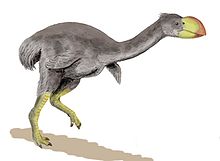 |
Dromornis stirtoni- this thing was 10 ft tall and weighed 1100 pounds!
|
So, during these quarantine days, I have been reading Sapiens and I came across a part mentioning how, as Homo sapiens spread all over the world, we caused (along with climate change) the extinction of a remarkable number of remarkable species. Take for example the countless species of megafauna all over the globe from the saber-toothed cats of North America to the giant Dromornis birds of Australia. upward
| A Great Film! |
Intrigued, I began looking up more about extinct species and came across the term de-extinction also known as resurrection biology which is the scientific process of bringing back extinct animals. Yes, it is real-life Jurassic Park, however, there’s a long road to reviving a dinosaur and let’s hope no one goes down that path.
There are three types of de-extinction:
Cloning- Scientists are able to use the DNA from the cell nucleus of the extinct species and insert it into an egg of a closely related species that is lacking a nucleus. They used this process on a bucardo, a goat-like creature that dwelled in parts of France, Portugal, and Spain. Bucardos went extinct in the year 2000, but before the last bucardo died, scientists got a sample of her DNA and implanted it in a goat in 2003. A new baby bucardo was born but died ten minutes later from the malformed lung. Since then, cloning has improved and scientists can now often successfully clone animals.
| A Bucardo |
Genome editing- Scientist are able to edit the DNA of an organism by cutting the DNA strand at certain points. As we know from our evolution unit when species are closely related they can share an astounding amount of DNA. So with some species, take for example the band-tailed pigeon and the extinct passenger pigeon. These two are share so much of the same DNA that with a little genome editing, the egg of a band-tailed pigeon could be “transformed” into a passenger pigeon.
| A passenger pigeon |
So now that we know bringing back extinct species is possible, the question remains: is this ethical? There are so many points to consider: If an animal’s species is extinct, how will it be raised and taught to survive? If the species became extinct in the first place, what if the environment is just too inhospitable, and bringing this creature back will only cause it to suffer? Is it wrong to alter “nature’s course?” And so on...
Although de-extinction is ethically questionable, the need for science like this becomes more prevalent as more and more animals reach the brink of extinction, and humans increasingly make this planet more inhospitable to some of it’s most magnificent creatures. Of course, there’s another side to this, that scientists may bring back certain creatures for entertainment rather than environmental restoration. As scientists begin to use this technology to bring back creatures that have been extinct for thousands of years such as woolly mammoths and even neanderthals, this scientific breakthrough begins to enter the realm of science fiction. I’m not sure how to feel about this technology, but I hope it is used with the utmost care, thought, and responsibility.
De-extinction seems to be a really interesting, and unfortunately increasingly important field of biology. I would argue that we should determine on a case by case basis if bring an extinct species back is ethical or not. For example, I do not believe it is wrong to alter nature's course as the vast amount of extinctions are due to humans, through destruction of the natural environment or climate change, but we should also not bring back a species that would be by any means a danger to humans.
ReplyDeleteThis is literally the coolest. Also you HAVE to read The Lost World now (the one w/Levine), it gets into the whole "If an animal’s species is extinct, how will it be raised and taught to survive?" question in a really fun way
ReplyDeleteI love Sapiens! It's one of my favorite books. The question as to whether de-extinction is ethical is a hard one. For species that go extinct due to human activity, it may be an easier call. But when it comes to bringing back Mammoths, I am conflicted. It would be very cool to see such a breathe taking species in real life, but they did go extinct for a reason.
ReplyDeleteThis makes me think of the Jurassic Park series (which I loved as a kid). I think that the topic of it being ethical is a sensitive one as everyone has different opinions on what is truly ethical. Like Miles, I am also conflicted on the issue.
ReplyDeleteSuper creepy gray area stuff I love it. It's weird to weigh the pros and cons of messing with nature like this, cause so many extinctions were our fault in the first place.
ReplyDeleteIt's so weird to think that scientists could bring back extinct species, and whether it's ethical or not as always been such an intriguing question to me. Similar to what Miles said, I do agree that some species, including Mammoths, went extinct for a reason so I hope that if scientists do use this technology, that they are careful.
ReplyDeleteIt is crazy that bringing back extinct species is even a conversation we can have. It's so sad how many species humans have caused to go extinct. I am also conflicted on this.
ReplyDelete